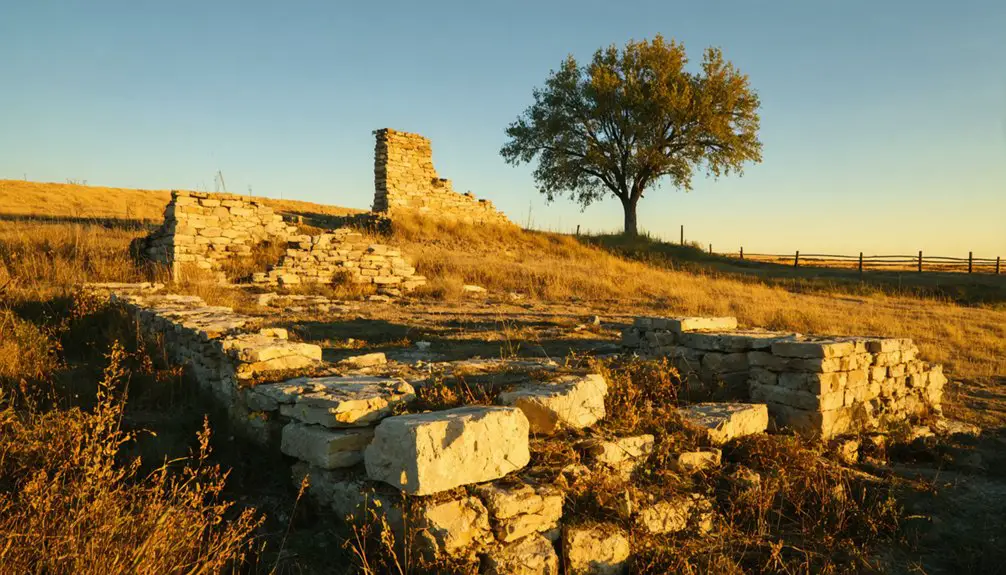You’ll find Bain City’s ruins along the Osage River in Bourbon County, Kansas, where abolitionists John Brown and Captain Oliver P. Bain established a fortified outpost in 1857. The log fortress served as a vital Underground Railroad station, housing up to 50 freedom seekers while defending against pro-slavery attacks. Though abandoned after Kansas achieved statehood in 1861, the site’s strategic role in “Bleeding Kansas” and the fight for freedom left an indelible mark on America’s path toward emancipation.
Key Takeaways
- Bain City originated in 1857 as Fort Bain, established by John Brown and Captain Oliver P. Bain along the Osage River.
- The settlement served as both a military outpost and Underground Railroad station, housing up to 50 people in its log cabin.
- After Kansas achieved statehood in 1861, Fort Bain’s strategic importance diminished, leading to its eventual abandonment.
- The community’s decline was hastened by the fort’s inadequate log structure and inability to support long-term settlement needs.
- The site became a ghost town following the end of border conflicts, transitioning to private ownership and losing its military significance.
Origins of Fort Bain and Early Settlement

While tensions mounted along the Kansas-Missouri border in 1857, John Brown and Captain Oliver P. Bain established a strategic fort on the north side of the Osage River in Bourbon County, Kansas.
The fort establishment consisted of a log cabin capable of housing 50 people, serving as both a military outpost and a crucial station on the Underground Railroad. During a significant confrontation, four pro-slavery men were killed when attacking the fort on December 2, 1857.
You’ll find that Fort Bain quickly became central to the region’s community dynamics, operating as a rendezvous point for abolitionists and a base for raids into Missouri. James Montgomery worked closely with John Brown in coordinating operations from the fort.
The fort’s presence intensified local disputes between Free-State supporters and pro-slavery forces, making it a powerful symbol of resistance.
Though the structure faced abandonment after U.S. Deputy Marshal John Little’s failed attack in December 1857, it had already secured its place in the fight for freedom along the Kansas-Missouri border.
Strategic Military Location and Purpose
Fort Bain’s strategic positioning along the Osage River in northern Bourbon County made it a formidable outpost in the Kansas-Missouri border conflict.
Perched along the Osage River, Fort Bain dominated the Kansas-Missouri frontier as a critical stronghold during border hostilities.
As a fortified log structure, you’ll find it played an essential role in military strategy during the tumultuous “Bleeding Kansas” period. The fort’s location provided critical surveillance of border movements while serving as a key station on the Underground Railroad. Like Fort Leavenworth’s history, the site was instrumental in protecting vital trade routes and settlers in the region. The fort’s construction reflected the growing need for defensive positions as partisan warfare intensified in the territory.
- Housed up to 50 people and successfully repelled pro-slavery attacks, including a notable defense that resulted in four attacker casualties
- Served as John Brown’s strategic planning base for Missouri raids and slave liberation operations
- Functioned as a crucial coordination point between abolitionists and freedom fighters, facilitating cross-border rescue missions
The fort’s position near the Missouri border proved instrumental in supporting broader abolitionist objectives and resisting pro-slavery forces.
The Underground Railroad Connection
As you trace Fort Bain’s hidden passageways and escape routes, you’ll discover how this fortified outpost served as a vital Underground Railroad station near the Missouri border, sheltering up to 50 freedom seekers at a time. Captain Oliver P. Bain constructed the log house in 1857 to assist anti-slavery efforts.
In December 1858, John Brown and his fellow abolitionists used the fort to coordinate their most daring slave liberation raid into Missouri, cementing the site’s role in organized resistance. Local conductors and station keepers provided essential support by offering food and temporary shelter to those seeking freedom.
The fort’s strategic location connected it to a wider network of safe houses stretching from Auburn to Wabaunsee County, with Quaker families and anti-slavery settlers maintaining secret routes that guided escaped slaves northward toward Nebraska.
Secret Routes and Passages
Through the dense network of the Underground Railroad, Bain City emerged as a critical waypoint for enslaved people seeking freedom in the late 1850s.
Operating from Fort Bain, abolitionists established secret passages that connected to stations in Wakarusa, Lawrence, and southern Lyon County. You’ll find that these clandestine routes shifted frequently to evade slave catchers and law enforcement, especially as activity intensified in 1857. As a vital escape channel, these routes connected directly to Trading Post and Osawatomie, ensuring a safer passage northward.
- Fort Bain served as a strategic hub for John Brown’s liberation raids into Missouri
- Routes connected to the main branch of the Lane Trail near the Nebraska border
- Local communities provided essential support to maintain the network’s secrecy
The proximity to Missouri made Bain City’s location ideal for rescue operations, though it also meant constant vigilance against pro-slavery forces.
Freedom Seekers’ Safe Haven
Situated near the volatile Missouri border, Bain City emerged as an essential sanctuary for freedom seekers during the tumultuous “Bleeding Kansas” period. The community’s heart, Fort Bain, could shelter up to 50 people and served as a critical safe haven for those escaping bondage.
You’ll find that John Brown and his fellow abolitionists used this strategic location to launch daring rescue missions into Missouri, including the December 1858 raid that freed multiple families. Most transport occurred under cover of darkness to protect escapees from proslavery kidnappers.
The fort withstood attacks from proslavery militias and U.S. Marshal John Little, while Captain Oliver P. Bain and local Free Staters coordinated protection and resources for escapees.
Through Bain City’s network of support, entire families found refuge and assistance in their journey northward to freedom, preventing their separation by slave traders across the border.
Abolitionist Network Operations
While establishing itself as a critical Underground Railroad hub, Bain City’s Fort Bain became the nerve center for coordinated abolitionist operations across the Kansas-Missouri border region. The fortified log house, led by Captain Oliver P. Bain, employed radical resistance strategies to protect freedom seekers and launch daring raids into Missouri.
You’ll find that John Brown’s December 1858 operations exemplified the fort’s tactical importance, as he coordinated multiple plantation raids from this strategic location.
- The fort’s network connected with safe houses throughout Wabaunsee, Auburn, and Lawrence, adapting routes when needed.
- Abolitionist strategies included military-style raids combined with peaceful Quaker assistance.
- The National Kansas Aid Committee provided essential logistical support for transport and resources.
The fort’s effectiveness drew the attention of proslavery forces, but it withstood numerous attacks, protecting its crucial mission until Kansas achieved statehood.
Notable Battles and Engagements

Fort Bain’s most notable military engagement occurred on December 2, 1857, when you’d have witnessed 50 abolitionist defenders successfully repelling an attack by roughly 500 proslavery forces, resulting in four attacker casualties.
Marshal Little’s subsequent attempts to capture the fort proved equally unsuccessful, as the fortification’s strategic position and determined defenders consistently thwarted his advances.
The fort’s elevated location above Mine Creek and its sturdy log construction made it an invaluable tactical stronghold for anti-slavery operations along the Kansas-Missouri border. During the Civil War, this area would later witness the Battle of Mine Creek, where Union forces decisively defeated Confederate General Sterling Price’s Army of Missouri in 1864. The surrounding region saw frequent settler patrols form to protect against perceived threats from local tribes.
December 1857 Armed Defense
In December 1857, a dramatic armed standoff unfolded at Fort Bain when Deputy U.S. Marshal John Little led an expedition from Fort Scott to capture the Bourbon County court.
You’ll find that Free-State settlers mounted fierce armed resistance against civil authority, forcing Little’s posse to retreat after sustaining four wounded men.
- Little’s second attack with ten volunteers met with equally determined defensive fire.
- When he returned with 150 men the next day, the defenders had relocated to Danford’s Mill Baptist Church.
- Nearly 300 Free-State settlers assembled at the church, though no further attacks occurred.
The conflict prompted Secretary of War to dispatch First United States Cavalry companies to Fort Scott, temporarily restoring order until January 1858.
Fort Bain’s strategic location near Missouri’s border made it essential for both defensive operations and Underground Railroad activities.
Marshal Little’s Failed Attacks
Deputy U.S. Marshal John Little’s failed strategies against Fort Bain began on December 16, 1857, when he led 50 men in an initial assault.
After sustaining four casualties and failing to breach the fort’s defenses, Little retreated only to return with a smaller force of ten men in a probing action that also proved unsuccessful.
Little’s persistent assaults culminated on December 17 when he arrived with 150 reinforcements, determined to eliminate the abolitionist stronghold.
You’ll find it significant that the Free Staters had strategically abandoned the fort by then, leaving Little’s substantial force without an enemy to engage.
The failed attacks ultimately strengthened Fort Bain’s symbolic status in the Free State resistance, enabling continued Underground Railroad operations and future raids by John Brown’s forces.
Tactical Military Significance
During the turbulent Bleeding Kansas period, several notable military engagements established the tactical significance of Fort Bain as a critical stronghold.
You’ll find this log fortification played a pivotal role in tactical maneuvers against pro-slavery forces, particularly during December 1857’s intense conflicts. The fort’s strategic location near the Missouri border made it invaluable for guerrilla warfare operations.
- The fort successfully repelled a major assault by 500 pro-slavery attackers on December 2, 1857, resulting in four enemy casualties.
- Deputy Marshal Little’s forces attempted multiple attacks between December 16-17, failing to capture the fortification.
- The installation’s 50-man capacity enabled substantial raiding parties to gather and launch liberation missions into Missouri.
Fort Bain’s defensive architecture and positioning proved essential for abolitionists resisting both pro-slavery militias and federal law enforcement actions.
Life at the Fort During Bleeding Kansas

While Fort Scott’s former military buildings stood as silent witnesses, the town became a stark reflection of America’s deepening slavery divide in the 1850s.
You’d find the Western Hotel filled with pro-slavery advocates, while across the parade ground, the Fort Scott Hotel sheltered those fighting for freedom. Political tensions erupted daily as the town’s pro-slavery population clashed with free-state settlers from the surrounding countryside.
Walking these streets meant choosing sides carefully. The U.S. Land Office and courts favored pro-slavery rulings, pushing free-staters to establish their own judicial system.
Violence became routine, with James Montgomery’s free-state forces battling U.S. troops at Paint Creek, and tragic events like the Marais des Cygnes Massacre highlighting the brutal reality of Bleeding Kansas at Fort Scott.
Abandonment and Disappearance
As Kansas achieved statehood in 1861, Fort Bain’s strategic importance rapidly faded into obscurity.
You’ll find the abandonment causes were directly tied to the end of border conflicts and the fort’s shift to private ownership. The original log structure, which had served as a vital meeting point for Free State forces, couldn’t sustain long-term settlement needs.
The community decline was inevitable, as the site never developed beyond its military purpose:
The fort’s fate was sealed from the start – a military outpost that never evolved into anything more.
- By December 1857, Free State forces had already abandoned the fort after U.S. Marshal attacks
- The original structure was razed and replaced years after the Bleeding Kansas conflicts
- No markers or ruins remain to commemorate the fort’s role in abolitionist resistance
Today, the fort’s remote location and lack of preservation efforts have erased nearly all physical traces of its existence.
Historical Impact on Kansas Territory

Fort Bain’s physical traces may have vanished, but its profound influence on Kansas Territory’s path to statehood remains indelible.
You’ll find the fort played a pivotal role in abolitionist strategies, serving as both a defensive stronghold and launching point for anti-slavery operations. Under John Brown’s leadership, the fortified outpost became central to civil rights advancement, protecting up to 50 freedom fighters while enabling raids into Missouri to liberate enslaved people.
The fort’s resistance against pro-slavery forces, including repelling attacks by U.S. Marshal John Little’s men, demonstrated Free State settlers’ unwavering commitment to abolition.
This determined stand helped shape Kansas Territory’s destiny, contributing directly to its 1861 admission as a free state and accelerating the nation’s march toward civil war.
Frequently Asked Questions
What Did the Fort’s Living Quarters and Interior Layout Look Like?
Like shadows in history’s mist, you’d find Fort Bain’s living quarters sparse and functional, with multi-purpose rooms accommodating 50 people. The interior layout featured simple spaces for sleeping, planning, and defense.
Were Any Artifacts or Personal Belongings Ever Recovered From the Site?
You won’t find direct records of artifact discoveries from this specific site, though nearby Kansas ghost towns commonly yield personal belongings like pottery shards, stone tools, glass fragments, and military buttons.
What Happened to Captain Oliver P. Bain After the Fort’s Abandonment?
You’ll find Bain’s legacy shrouded in mystery, as the Captain’s fate remains undocumented after December 17, 1857. Historical records don’t reveal where he went following Fort Bain’s abandonment.
How Many Escaped Slaves Successfully Passed Through Fort Bain?
While exact numbers aren’t documented, you’ll find records showing at least 10 slaves freed during Brown’s 1858 raid, with many more using Fort Bain’s abolitionist routes for their escaped journeys to freedom.
Did Local Native American Tribes Interact With the Fort’s Inhabitants?
While tribal relations existed between Fort Leavenworth and Native peoples, you’ll find no clear evidence of fort diplomacy specifically at Bain City in surviving archival records from the area.
References
- https://en.wikipedia.org/wiki/Fort_Bain
- https://www.youtube.com/watch?v=ZW1vY3Qsj9s
- https://www.youtube.com/watch?v=alC1wDdSVvg
- https://legendsofkansas.com/franklin-county-extinct-towns/
- https://www.legendsofamerica.com/fort-bain-kansas/
- https://civilwaronthewesternborder.org/map/fort-bain
- https://civilwaronthewesternborder.org/geographic-subject/bourbon-county-kansas
- https://legendsofkansas.com/bourbon-county-border-troubles/
- https://www.veteranpcs.com/blog/what-military-bases-are-in-kansas
- https://en.wikipedia.org/wiki/Kansas_forts_and_posts



